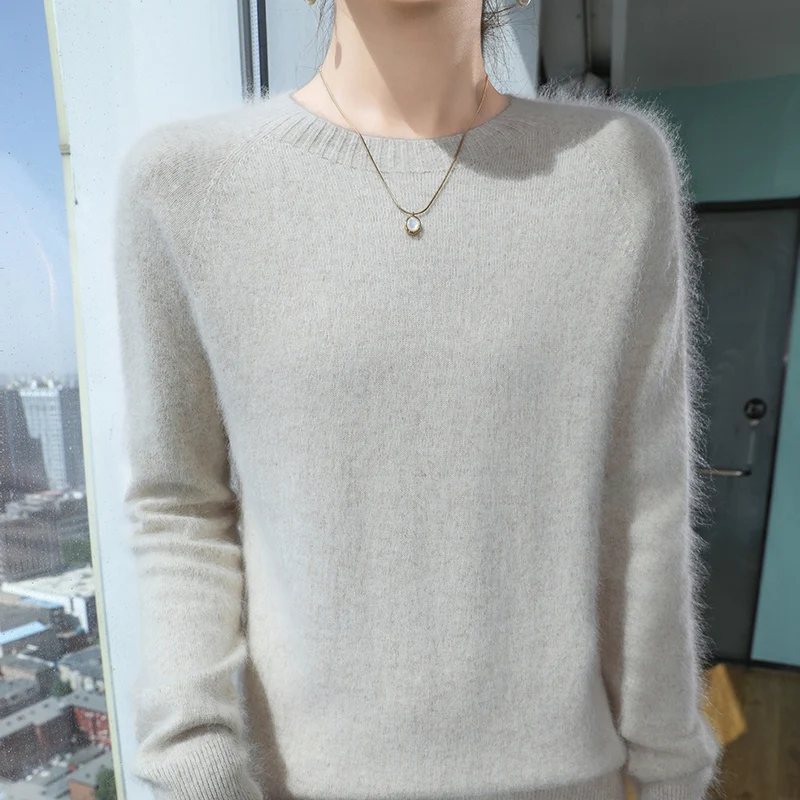Beyond Winter: The Year-Round Appeal of Lightweight Cashmere
Lightweight cashmere refers to garments crafted from single-ply or fine gauge cashmere fibers, typically measuring 14-16 microns in diameter, creating fabric that’s remarkably thin yet insulating. Unlike its heavier counterparts, these delicate pieces offer exceptional breathability while maintaining cashmere’s legendary softness and warmth.
Many people mistakenly believe cashmere belongs exclusively to winter wardrobes, tucked away once temperatures rise. This outdated thinking misses the remarkable versatility of lightweight cashmere, which thrives across seasons and diverse climates. The finer gauge construction allows these pieces to regulate body temperature rather than simply provide warmth, making them uniquely suited for fluctuating environments.
The evolution of cashmere transitional weather garments represents a significant advancement in luxury fabrics. While traditional winter cashmere might use 4-8 ply construction for maximum insulation, contemporary lightweight options utilize 1-2 ply techniques, creating versatile pieces that adapt to your body’s needs without overwhelming it with unnecessary warmth.
Modern manufacturing techniques have transformed cashmere from a seasonal indulgence to an everyday luxury. Understanding the lightweight cashmere essential guide helps appreciate how these garments maintain their premium qualities while serving more versatile purposes than their traditional counterparts.
The Science Behind Cashmere’s Thermoregulation
Unique Fiber Structure
Cashmere’s exceptional performance begins with its remarkable fiber structure. These natural fibers feature:
- Hollow cores that trap air while remaining extremely fine (14-19 microns in diameter)
- Natural crimps creating microscopic air pockets throughout the fabric
- Significantly finer diameter than human hair (approximately 75 microns) or typical wool
This distinctive structure gives lightweight cashmere unprecedented advantages for comfort across varying temperatures. The right cashmere thickness plays a crucial role in how effectively these garments regulate temperature, with lightweight options optimized for versatility rather than maximum insulation.
Exceptional Insulation Properties
Despite its delicate feel, lightweight cashmere provides remarkable warmth. The hollow fiber core traps body heat efficiently, creating a natural insulating layer that can be up to eight times warmer than traditional sheep’s wool by weight. This impressive warmth-to-weight ratio means even the thinnest cashmere garments provide substantial protection against cooler temperatures without the bulk associated with other insulating materials.
Temperature regulation tests consistently show that lightweight cashmere maintains a comfortable microclimate around the body even as external temperatures fluctuate. This natural insulation works without creating the stifling sensation often experienced with synthetic alternatives.
Natural Breathability & Airflow
Lightweight cashmere’s natural porosity allows continuous air exchange between the fabric and environment. The fibers themselves respond dynamically to conditions, subtly expanding and contracting with temperature and humidity changes. This natural breathability prevents overheating by allowing excess warmth to dissipate when temperatures rise.
Air permeability measurements show lightweight cashmere allows significantly more airflow than comparable synthetic fibers, while maintaining comfort in a broad temperature range (typically 65-80°F/18-27°C). This breathability distinguishes premium cashmere from lower-quality alternatives that might provide warmth but lack temperature adaptability.
Superior Moisture-Wicking Properties
Lightweight cashmere can absorb approximately 30% of its weight in moisture without feeling damp to the touch. This remarkable capacity draws perspiration away from your skin, allowing it to evaporate at the fiber surface rather than creating uncomfortable dampness against your body.
The moisture management properties work in harmony with cashmere’s breathability and insulation, creating a comprehensive temperature regulation system. In humid conditions or during activity, this wicking ability helps maintain consistent comfort where other materials might become clammy or chilling.
Why Lightweight Cashmere Excels in Fluctuating Climates

Seamless Transitional Seasons
Lightweight cashmere truly shines during spring and fall when temperatures can swing dramatically throughout the day. Morning chills, afternoon warmth, and evening coolness create challenging dressing conditions that single-weight garments rarely manage effectively. Lightweight cashmere performs optimally across a wide temperature band (45-75°F/7-24°C), precisely where most transitional weather falls.
The material’s adaptive properties mean a single piece can provide comfortable warmth during a crisp spring morning commute, prevent overheating during a sunny afternoon, and offer protection against cooling evening breezes. Understanding how to layer cashmere for spring and fall allows you to maximize this versatility across unpredictable seasonal shifts.
Traveler’s Essential
For travelers navigating multiple climates in a single journey, lightweight cashmere provides unmatched versatility. These pieces typically weigh just 5-8 ounces (140-225 grams), taking minimal space while offering maximum adaptability across diverse environments. Their natural wrinkle resistance means they emerge from luggage ready to wear without special treatment.
The temperature regulation properties prove particularly valuable for air travel, where cabin environments notoriously fluctuate between too warm and too cold. A lightweight cashmere layer provides comfort throughout the journey and easily adapts to destination climates. Learning temperature adaptation strategies with cashmere layers helps travelers maintain comfort while minimizing packing volume.
Indoor-Outdoor Comfort
Modern environments frequently create challenging temperature differentials. Office buildings might maintain air conditioning at 68°F (20°C) while outdoor temperatures reach 85°F (29°C) or higher. These 15-25°F (8-14°C) differentials create significant comfort challenges throughout the day.
Lightweight cashmere navigates these transitions seamlessly, providing just enough warmth for air-conditioned spaces without becoming overwhelming when stepping outside. This adaptability makes these pieces particularly valuable for professional environments where comfort and appearance must be maintained across varying conditions and day-to-evening transitions.
Year-Round Adaptability
While most fabrics have distinct seasonal limitations, lightweight cashmere offers surprising year-round utility. Summer evenings often bring unexpected chills, while over-air-conditioned restaurants and theaters create cold spots even on the warmest days. A lightweight cashmere wrap or cardigan provides elegant protection without feeling seasonally inappropriate.
In winter, these same pieces create effective layering options beneath heavier outerwear, adding warmth without bulk. Their temperature-regulating properties prove valuable even in heated indoor environments where traditional winter garments become uncomfortable. Understanding year-round cashmere comfort strategies helps maximize the versatility of these investments across all seasons.
Essential Lightweight Cashmere Garments for Versatile Styling
Fine Gauge Sweaters
Lightweight cashmere sweaters, typically knit at 12-14 gauge for exceptional breathability, offer the perfect balance of polish and comfort for variable conditions. Options include:
- Crew necks and V-necks for classic versatility
- Cardigans that can be easily added or removed as temperatures change
- Short-sleeve or sleeveless styles for warmer climates requiring minimal insulation
These pieces typically weigh 7-9 ounces (200-250 grams) and perform beautifully across temperature ranges that would challenge thicker knits. Browse our cashmere sweater collection to discover options specifically designed for temperature versatility.
Travel Wraps & Shawls
Lightweight cashmere wraps represent perhaps the ultimate versatile garment. Typically measuring around 28×80 inches (70×200 cm), these generously sized pieces serve multiple functions: elegant scarf, shoulder wrap for evening chills, makeshift blanket for travel, or even sun protection in bright conditions.
Their lightweight construction (usually 6-8 ounces/170-225 grams) makes them easy to carry while providing substantial comfort when needed. Explore our cashmere wrap sweaters for pieces specifically designed for adaptable styling across temperature variations.
Cashmere Scarves
Lightweight cashmere scarves provide targeted warmth for neck and shoulders while adding visual interest to outfits. Typically measuring approximately 12×70 inches (30×180 cm) and weighing just 3-4 ounces (85-115 grams), these accessories tuck easily into bags for on-demand temperature adjustment.
The weave significantly impacts performance – looser, more open constructions offer gentle warming for mild conditions, while tighter weaves provide more substantial protection against cooler temperatures. Multiple styling options (loosely draped, wrapped, or knotted) allow further adaptation to changing conditions throughout the day.

Open-Knit & Blended Pieces
Specialized constructions further enhance lightweight cashmere’s temperature-regulating properties. Open-knit garments incorporate strategic spacing between fibers, increasing airflow for warmer conditions while maintaining cashmere’s inherent benefits.
Thoughtful blends combine cashmere with complementary fibers for enhanced performance:
* Cashmere-silk blends (typically 70% cashmere/30% silk) add lustrous drape and cooling properties
* Cashmere-cotton combinations (approximately 85% cashmere/15% cotton) provide additional structure and durability
These short sleeve cashmere sweaters offer exceptional performance in moderate temperatures where traditional cashmere might prove too warm.
Lightweight Loungewear
Temperature regulation benefits extend to sleep and relaxation environments where comfort proves particularly crucial. Lightweight cashmere loungewear – including pants, shorts, and robes – creates a microclimate that adapts to body temperature fluctuations throughout rest periods.
These pieces typically weigh significantly less than traditional loungewear while providing superior comfort. The moisture-wicking properties prove particularly valuable during sleep, helping maintain consistent body temperature and potentially improving sleep quality.
Styling Strategies for Dynamic Temperatures
Understanding year-round layering techniques helps maximize lightweight cashmere’s adaptability across changing conditions.
The Art of Layering
Effective temperature management begins with strategic layering, creating a system that can be adjusted as conditions change:
- Start with breathable base layers that wick moisture directly from skin
- Add lightweight cashmere as a mid-layer that provides adaptable insulation
- Include an optional outer layer for wind or weather protection if needed
This approach allows quick adaptation – removing or adding pieces as temperatures shift throughout the day. The natural stretch and recovery of lightweight cashmere make it ideal for layering without creating uncomfortable bulk or restricting movement.
Seasonal Styling Tips
Each season presents unique styling opportunities for lightweight cashmere:
Spring/Summer: Pair with linen, lightweight cotton, and brighter colors for seasonal freshness. Choose open weaves and single-ply constructions for maximum breathability.
Fall/Winter: Layer over silk or technical base layers and under heavier outerwear. Deeper colors complement seasonal aesthetics while providing practical warmth.
The benefits of lightweight cashmere layers extend beyond temperature regulation to include creating visually interesting outfits with dimension and textural contrast across seasons.
Accessorizing for Adaptability
Lightweight cashmere accessories provide instant temperature adjustment without requiring complete outfit changes. A carefully selected scarf, wrap, or light sweater can transform comfort levels within seconds of changing conditions.
Multiple styling methods for a single piece (for example, transitioning a wrap from loosely draped to fully wrapped) allow further temperature fine-tuning. These versatile accessories often provide the perfect solution for unpredictable environments where conditions might change several times throughout the day.
Fit & Silhouette
Fit significantly impacts temperature regulation performance. Slightly relaxed silhouettes allow optimal airflow around the body, enhancing the natural breathability of lightweight cashmere. This more generous cut provides comfortable adaptability across varying conditions.
The natural drape of premium cashmere creates flattering silhouettes even in these relaxed fits. The material naturally skims rather than clings to the body, creating elegant lines regardless of specific styling choices.

A Buyer’s Guide to Quality Lightweight Cashmere
Understanding Ply Count
Ply count refers to the number of yarn strands twisted together to create cashmere thread. For temperature-adaptive pieces, focus on:
- 1-ply construction for maximum lightness and breathability
- 2-ply for slightly more structure while maintaining adaptability
These lighter constructions contrast with winter-focused garments that might use 4-ply or higher for maximum insulation. Understanding cashmere ply considerations helps select pieces appropriate for specific temperature regulation needs.
Assessing Fiber Quality
Premium lightweight cashmere features Grade A fibers measuring under 16.5 microns in diameter with minimum 36mm length. These specifications ensure optimal softness, durability, and temperature regulation properties.
Quality assessment techniques include:
* Evaluating hand-feel for exceptional smoothness without scratchiness
* Looking for natural luster rather than artificial sheen
* Assessing resistance to pilling during gentle handling
Higher-grade fibers not only provide superior comfort but maintain their temperature-regulating properties longer through repeated wear and washing.
Weave and Gauge
The technical construction significantly impacts performance characteristics. Fine gauge knitting (12-16 gauge) creates the lightweight, breathable fabric necessary for temperature regulation. Higher gauge numbers indicate finer needles and lighter, more flexible fabric.
Open weaves enhance airflow in warmer conditions, while maintaining cashmere’s insulating properties for cooler periods. This construction versatility allows manufacturers to optimize pieces for specific temperature ranges while maintaining the essential benefits of cashmere fiber.
Material Composition
Pure cashmere provides unparalleled softness and natural temperature regulation. However, thoughtfully created blends sometimes enhance specific performance aspects:
- Cashmere-silk blends improve drape and cooling properties for warmer conditions
- Cashmere-cotton combinations add structure and durability for frequent wear
Our women’s cashmere pullover collection includes both pure cashmere and carefully selected blends designed for optimal temperature versatility.
Cashmere Wrap Sweaters, Women's Cashmere Pullovers
$75.89 Select options This product has multiple variants. The options may be chosen on the product pageCashmere Cable Knit Sweaters, Women's Cashmere Pullovers
Price range: $111.82 through $112.93 Select options This product has multiple variants. The options may be chosen on the product pageCropped Cashmere Sweaters, Women's Cashmere Pullovers
$155.77 Select options This product has multiple variants. The options may be chosen on the product pageOversized Cashmere Sweaters, Plus Size Cashmere Sweaters, Women's V-Neck Cashmere Sweaters
$136.87 Select options This product has multiple variants. The options may be chosen on the product pageStriped Cashmere Sweaters, Women's Cashmere Pullovers
$139.68 Select options This product has multiple variants. The options may be chosen on the product pageMen's Cashmere Pullovers, Men's V-Neck Cashmere Sweaters
Price range: $90.79 through $96.98 Select options This product has multiple variants. The options may be chosen on the product page
Ethical Sourcing and Sustainability
Quality lightweight cashmere comes from producers committed to sustainable and ethical practices. Look for transparency regarding:
- Harvesting methods (combing rather than shearing)
- Animal welfare standards in herding practices
- Environmental considerations in processing and dyeing
Responsibly produced cashmere typically offers superior performance characteristics while providing peace of mind regarding its production journey.
Price vs. Value
Premium lightweight cashmere represents a significant investment compared to synthetic alternatives or lower-grade cashmere. However, the long-term value equation heavily favors quality:
- Superior temperature regulation performance across diverse conditions
- Exceptional durability when properly maintained (5+ years of regular use)
- Timeless aesthetic that transcends seasonal fashion cycles
When calculating cost-per-wear, high-quality lightweight cashmere often proves more economical than frequently replaced lower-quality alternatives.
Caring for Your Lightweight Cashmere to Maintain Performance
Gentle Washing Techniques
Proper cleaning preserves the temperature-regulating properties of lightweight cashmere:
- Hand wash using lukewarm water (below 86°F/30°C) and specialized cashmere shampoo
- Alternatively, machine wash using mesh garment bags on the gentlest cycle with cold water
- Use minimal soap and avoid standard detergents that strip natural oils
Following long-term cashmere garment care practices ensures these pieces maintain their exceptional temperature regulation capabilities throughout their lifespan.
Drying Correctly
Improper drying techniques represent the greatest risk to lightweight cashmere’s performance:
- Never wring or twist the wet garment
- Gently press excess water using clean towels
- Reshape while damp and dry flat on absorbent towels away from direct heat or sunlight
Expect drying to take 24-48 hours depending on environmental conditions. This patience preserves the fabric’s structure and temperature-regulating properties.
Proper Storage
Between wearings, proper storage protects lightweight cashmere from damage:
- Fold rather than hang to prevent stretching
- Store in breathable cotton garment bags rather than plastic
- Include natural moth deterrents such as cedar blocks or lavender sachets
For extended storage, clean pieces thoroughly before storing to remove any compounds that might attract pests or cause fiber damage over time.
Managing Pilling
Surface pilling occurs naturally with even the finest cashmere but doesn’t indicate quality issues:
- Remove pills using specialized cashmere combs or fabric shavers designed for delicate materials
- Work gently across small sections rather than aggressive removal techniques
- Address pilling promptly rather than allowing buildup that becomes more difficult to remove
Regular, gentle maintenance preserves both the aesthetic appeal and temperature-regulating performance of lightweight cashmere pieces.
Beyond Function: The Enduring Benefits of Lightweight Cashmere
Unrivaled Softness & Comfort
The exceptional softness of premium lightweight cashmere creates a sensory experience beyond mere functionality. The fibers’ fine diameter and natural crimp produce a gentle touch against skin that synthetic alternatives simply cannot replicate.
This inherent softness proves particularly valuable for those with sensitive skin conditions. The natural fibers rarely cause irritation, making lightweight cashmere an excellent option for direct skin contact in variable temperature environments where comfort becomes particularly crucial.
Durability and Longevity
Quality lightweight cashmere represents a long-term investment in comfort. With proper care, premium pieces maintain their temperature-regulating properties for 5+ years of regular wear, substantially outlasting lower-quality alternatives.
This exceptional lifespan translates to significant value over time. While the initial investment might exceed other options, the extended service life and consistent performance make lightweight cashmere economically sensible when evaluated across its full usable lifespan.
Timeless Style & Elegance
Lightweight cashmere transcends seasonal fashion trends, offering enduring elegance that remains appropriate year after year. The material’s natural drape creates flattering silhouettes across diverse body types and styling approaches.
This timeless quality extends beyond aesthetics to functionality – pieces purchased today will serve equally well in coming years, making them sustainable choices from both environmental and financial perspectives.
Embrace the Adaptive Luxury
Lightweight cashmere represents a remarkable convergence of luxury and functionality. Its unparalleled ability to regulate temperature across changing conditions makes these pieces uniquely valuable in contemporary wardrobes where versatility and comfort are increasingly prioritized.
The exceptional fibers, with their hollow cores and natural crimp, create a fabric that responds dynamically to both environmental conditions and body temperature. This adaptive quality distinguishes lightweight cashmere from alternatives that might excel in specific conditions but lack versatility across temperature ranges.
Investing in quality lightweight cashmere pieces delivers both immediate comfort and long-term value. These garments serve faithfully across seasons and years, providing consistent performance while maintaining their aesthetic appeal. For those navigating variable temperatures with elegance, lightweight cashmere offers the perfect balance of luxury and practicality.







